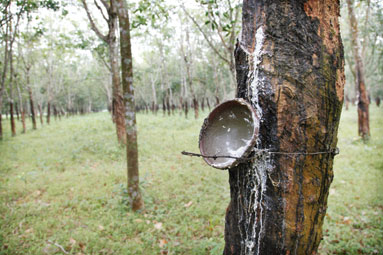

Rubber trees at a plantation in Kampong Cham province’s Memot district last year.
Siem Reap province
Cambodia would produce 353,000 tonnes of rubber annually by 2020, in an aim to take advantage of growing international demand, General Directorate of Rubber Plantations head Ly Phalla said at a conference in Siem Reap yesterday.
Claiming international supply of natural rubber fell 2.6 percent below demand last month, he said Cambodia was well placed to boost future production.
“We still have a chance to develop the rubber sector because at the present time we plant on a smaller scale,” he said.
Earlier this month, the Ministry of Commerce reported rubber exports from Cambodia amounted to 30,039 tonnes last year, down from 35,482 tonnes in 2009. It blamed increased smuggling as the reason for the decline in official figures.
The Kingdom’s rubber plantations amounted to 181,450 hectares in 2010, though there was 300,000 hectares of land suitable for the crop, according to figures circulated at the conference.
Cambodia’s producers aim to plant some 30,000 to 40,000 hectares of the crop in 2011, said Ly Phalla, adding it was an increase on the 20,000 hectares planted last year.
Experts from Cambodia, Thailand, Vietnam, Indonesia, Malaysia and China gathered in Siem Reap for the summit, which began yesterday, with the aim of tackling concerns about decreasing production and increased demand.
“The meeting is a gathering to show the world the opportunity for investment in rubber in Cambodia, and that it can increase rubber production in the future,” Ly Phalla said.
But although worldwide demand is increasing, experts said producers in some countries are switching to other crops – creating a concern about the lack of rubber production in the future.
Mohd Faris Adli Shkery, vice president of Sime Darby Plantation Sdn Bhd, said Malaysia is increasingly planting palm oil instead of rubber, because oil produces results in a shorter time frame and with less labour needed.
Palm oil can be produced within three years, requiring only one expert per 12 hectares, whereas rubber takes 6 years with one expert for every 5 hectares, he said during a presentation at the conference.
Elson Ng, chief advisor to the chief executive officer of Singapore-based rubber producers GMG Global Limited, said the meeting brought together experts to exchange experiences and develop the sector.
Rubber prices declined yesterday as China stepped up measures to rein in liquidity, dimming demand prospects from the biggest user. Rubber reached a record ¥535.7 per kilogramme on February 18.
ADDITIONAL REPORTING BLOOMBERG
Contact PhnomPenh Post for full article
Post Media Co LtdThe Elements Condominium, Level 7
Hun Sen Boulevard
Phum Tuol Roka III
Sangkat Chak Angre Krom, Khan Meanchey
12353 Phnom Penh
Cambodia
Telegram: 092 555 741
Email: [email protected]












